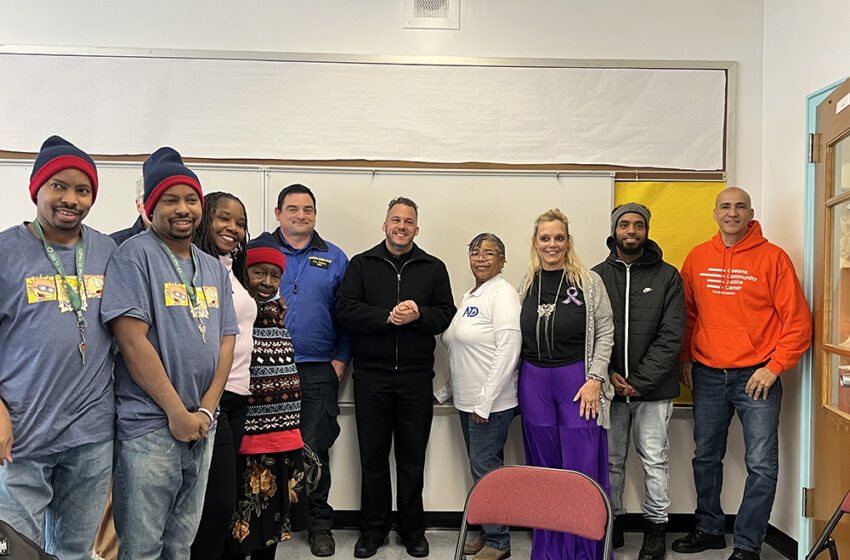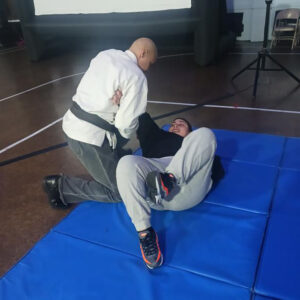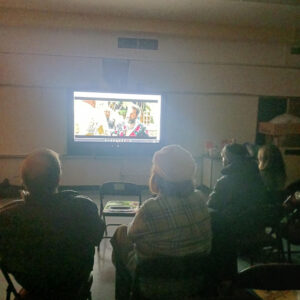A Month for Human Trafficking Awareness

By Katie McFadden
January is Human Trafficking Awareness month, and all month, through her organization, Xtrememeasure, Theresa Racine has been collaborating with community partners and law enforcement agencies to spread as much awareness about this dangerous worldwide movement as she can. From informational forums to a self-defense seminar and special screenings of the film, “Sound of Freedom,” some in Rockaway have taken the opportunity to become more informed about human trafficking.
 Before the various events this month, Racine explained why she feels so strongly about spreading awareness for human trafficking. “My daughter was trafficked. I have friends that have had kids that were trafficked,” she said. “This is deep to my heart.” And it’s why she organized three separate awareness events in the hopes of making an impact on people, so they know what to look for or how to seek help. “We have these events so this won’t become someone else’s story,” Racine told The Rockaway Times.
Before the various events this month, Racine explained why she feels so strongly about spreading awareness for human trafficking. “My daughter was trafficked. I have friends that have had kids that were trafficked,” she said. “This is deep to my heart.” And it’s why she organized three separate awareness events in the hopes of making an impact on people, so they know what to look for or how to seek help. “We have these events so this won’t become someone else’s story,” Racine told The Rockaway Times.
It all started on Wednesday, January 17, as Racine teamed up with Queens Community Justice Center- The Rockaways on Beach 20th Street to host an Anti-Human Trafficking Community Forum. As Queens District Attorney Melinda Katz’ office now has a bureau that focuses on human trafficking, assistant district attorney Kiran Cheema was on hand to give a presentation laying out the definitions and types of human trafficking, what to look out for, and what the DA’s office has been doing to prosecute cases and help victims. A panel also included Estelle Davis from the NYS Office of Temporary and Disability Assistance, Gloria Lewis from the New Day Treatment Center in Far Rockaway, Jason Lyons from the American Red Cross, and 101st Precinct officers Jamaal Arthur and Dominick Farese, who were on hand to explain what role they play in combatting human trafficking, and to answer panel questions.
 Cheema explained that while some might think of human trafficking as a situation in which someone is smuggled into the country and forced into prostitution or labor, moving from place to place, it comes down to something much simpler and sometimes, closer to home. “What sex trafficking is, is requiring that prostitution be performed in exchange for money through the use of force, fraud, or coercion.” However, when it comes to minors, there only needs to be proof that an adult is profiting from a child’s labor or prostitution. She also added that trafficking can take place in a single room and doesn’t always require a victim to move around from place to place.
Cheema explained that while some might think of human trafficking as a situation in which someone is smuggled into the country and forced into prostitution or labor, moving from place to place, it comes down to something much simpler and sometimes, closer to home. “What sex trafficking is, is requiring that prostitution be performed in exchange for money through the use of force, fraud, or coercion.” However, when it comes to minors, there only needs to be proof that an adult is profiting from a child’s labor or prostitution. She also added that trafficking can take place in a single room and doesn’t always require a victim to move around from place to place.
While trafficking seems to be something that goes under the radar and behind closed doors, hundreds are affected by it in New York. As Davis said, “statistically, we’re looking at 600 people a year that are identified as victims, but 50-75% of cases are never identified. People don’t want to or are afraid to come forward, so the actual number of cases is probably even higher.”
And according to the 101st Precinct officers, Rockaway is not spared. “There is some trafficking going on in Rockaway,” one officer said, without giving specifics as there are ongoing investigations into these incidents.
 The panelists explained that anyone at any time can become a victim, no matter their age, nationality, gender, etc., but there are some things that make people more vulnerable, such as drug addiction, mental health issues and economic vulnerability, something they said has worsened in recent years due to the covid pandemic and inflation.
The panelists explained that anyone at any time can become a victim, no matter their age, nationality, gender, etc., but there are some things that make people more vulnerable, such as drug addiction, mental health issues and economic vulnerability, something they said has worsened in recent years due to the covid pandemic and inflation.
For someone who hasn’t received training, it can be hard to identify a trafficking situation, but Cheema said there are certain things to look out for, “If a person can’t go five feet ahead of someone or they’re following them or someone they’re with snatches their phone away, or you see a weird age gap with someone younger and the other person is paying for their things, those are some things to look for but it’s tough to identify.”
But everyone encouraged people to say something if they see something and to not be afraid to reaching out to their agencies for assistance if they find themselves in that situation or see someone becoming a victim. Racine also encouraged people to call the National Human Trafficking Hotline at 1-888-373-7888.
The second event was held on Friday, January 19 at the Child Center of NY (57-10 Beach Channel Drive), with the first screening of “Sound of Freedom.” The intense film tells the true story of Homeland Security Agent Tim Ballard, who took on a mission to recover children sold into sex trafficking. However, before the screening, guests were treated to some lessons on how to defend themselves. Moises Reyes of the Queens Community Justice Center led a self-defense seminar. The event also included tables from various agencies that shared resources on human trafficking.
The final event was another screening of “Sound of Freedom” at St. Rose of Lima Catholic Academy on Beach 84th Street on Saturday, January 20. Before the film, there were tables with information from New Day Treatment Center, the FBI, the Queens Community Justice Center – The Rockaways and the NYPD, who all had representatives that joined for a discussion. Father James Rodriguez addressed the room before the movie screening, saying, “This movie is excellent, powerful, strong, and a little painful at times.” However, he went on to explain to The Rockaway Times why he felt it was important for people to see it. “Human trafficking is one of those things that thrives in darkness and when people aren’t talking about it or people think ‘it doesn’t affect me, it’s not that big of a deal,’ it allows it to grow. One of the things the movie shows, and the statistics show, is that this is a serious issue that really spans the globe, so in such a diverse area like this, I think it’s important to talk about global issues because we’re all effected by them.”
Crime Prevention Officer Jason Farrell of the 100th Precinct reiterated the reality of the issue, saying, “It is a real thing. It’s something that’s almost a never-ending battle. But it’s not something we are going to stop fighting against. We have to fight for these people that can’t fight for themselves,” Farrell said.
Retired FBI agent Mike Dougherty explained it could be something in plain view that’s not so obvious, especially when it comes to labor trafficking. He explained an incident where a couple from India opened a hotel in Long Island and imported women from India to work at the hotel, gradually forcing them into prostitution. There was also a case where an OSHA complaint led to the discovery of several women from China who were forced to work at a nail salon in Manhattan. “They promise to get them a green card and bring them from the airport to an apartment building and force them to turn over their passports and then they’re trapped. The women were working at the nail salon as slaves,” Dougherty said. He also explained that when it comes to sex trafficking, a lot of it takes place on the dark web, where people are bought and sold on the internet.
The internet is where Sarah Sankarsingh said a man in his 40s caught the attention of her teenage daughter who was dealing with bipolar disorder. Her daughter had a habit of running away and Sankarsingh says she received little support when her daughter became a victim. “He coerced her on Snapchat to meet him. She thought he was close to her age. He wasn’t. He took her phone, shoes, coat, and had her on Queens Boulevard hopping from one hotel to the next for over a month,” she said. She credits Racine for helping to get her story out there on TV and connecting her with resources, but despite that attention, it took Racine helping Sankarsingh find her daughter’s secret Instagram, and her daughter finding an opportunity to escape her captor while he was sleeping, for her to finally be brought home. She explained that she tried to contact the 114th Precinct in Astoria where she lives, but they advised her to call 911 and by the time cops got to the hotel, the suspect had fled. And despite knowing who he is, she claims that police haven’t arrested him. “I didn’t have support from the cops,” she said.
Something that people took away from Sankarsingh’s story was the importance of reporting something when they see something. “One thing I can take from this is that someone had to see her. We see missing kids on TV all the time. Do I really take a look? How often do we see these things? If we can all just step that up and really look at these things, one person can do their part,” Lewis of the New Day Treatment Center said. Another attendee responded, “All it takes is one person to react. We need changes like that.”


